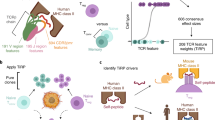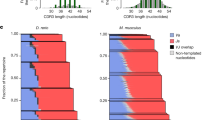Abstract
An αβ T-cell response depends on the recognition of antigen plus major histocompatibility complex (MHC) proteins1 by its antigen receptor (TCR). The ability of peripheral αβ T cells to recognize MHC is at least partly determined by MHC-dependent thymic selection, by which an immature T cell survives only if its TCR can recognize self MHC2,3,4,5,6,7. This process may allow MHC-reactive TCRs to be selected from a repertoire with completely random and unbiased specificities. However, analysis of thymocytes before positive selection indicated that TCR proteins might have a predetermined ability to bind MHC8,9,10,11. Here we show that specific germline-encoded amino acids in the TCR promote ‘generic’ MHC recognition and control thymic selection. In mice expressing single, rearranged TCR β-chains, individual mutation of amino acids in the complementarity-determining region (CDR) 2β to Ala reduced development of the entire TCR repertoire. Altogether, these results show that thymic selection is controlled by germline-encoded MHC contact points in the αβ TCR and indicate that the diversity of the peripheral T-cell repertoire is enhanced by this ‘built-in’ specificity.
This is a preview of subscription content, access via your institution
Access options
Subscribe to this journal
Receive 51 print issues and online access
$199.00 per year
only $3.90 per issue
Buy this article
- Purchase on Springer Link
- Instant access to full article PDF
Prices may be subject to local taxes which are calculated during checkout




Similar content being viewed by others
References
Zinkernagel, R. M. & Doherty, P. C. Restriction of in vitro T cell-mediated cytotoxicity in lymphocytic choriomeningitis within a syngeneic or semiallogeneic system. Nature 248, 701–702 (1974)
Bevan, M. J. In a radiation chimaera, host H-2 antigens determine immune responsiveness of donor cytotoxic cells. Nature 269, 417–418 (1977)
Fink, P. J. & Bevan, M. J. H-2 antigens of the thymus determine lymphocyte specificity. J. Exp. Med. 148, 766–775 (1978)
Zinkernagel, R. M. et al. On the thymus in the differentiation of “H-2 self-recognition” by T cells: evidence for dual recognition? J. Exp. Med. 147, 882–896 (1978)
Kisielow, P., Teh, H. S., Bluthmann, H. & von Boehmer, H. Positive selection of antigen-specific T cells in thymus by restricting MHC molecules. Nature 335, 730–733 (1988)
Sha, W. C. et al. Positive and negative selection of an antigen receptor on T cells in transgenic mice. Nature 336, 73–76 (1988)
Jameson, S. C., Hogquist, K. A. & Bevan, M. J. Positive selection of thymocytes. Annu. Rev. Immunol. 13, 93–126 (1995)
Jerne, N. K. The somatic generation of immune recognition. Eur. J. Immunol. 1, 1–9 (1971)
Zerrahn, J., Held, W. & Raulet, D. H. The MHC reactivity of the T cell repertoire prior to positive and negative selection. Cell 88, 627–636 (1997)
Merkenschlager, M. et al. How many thymocytes audition for selection? J. Exp. Med. 186, 1149–1158 (1997)
Blackman, M. et al. The T cell repertoire may be biased in favor of MHC recognition. Cell 47, 349–357 (1986)
Marrack, P., Scott-Browne, J. P., Dai, S., Gapin, L. & Kappler, J. W. Evolutionarily conserved amino acids that control TCR–MHC interaction. Annu. Rev. Immunol. 26, 171–203 (2008)
Rudolph, M. G., Stanfield, R. L. & Wilson, I. A. How TCRs bind MHCs, peptides, and coreceptors. Annu. Rev. Immunol. 24, 419–466 (2006)
Dai, S. et al. Crossreactive T cells spotlight the germline rules for αβ T cell-receptor interactions with MHC molecules. Immunity 28, 324–334 (2008)
Feng, D., Bond, C. J., Ely, L. K., Maynard, J. & Garcia, K. C. Structural evidence for a germline-encoded T cell receptor–major histocompatibility complex interaction ‘codon’. Nature Immunol. 8, 975–983 (2007)
Maynard, J. et al. Structure of an autoimmune T cell receptor complexed with class II peptide–MHC: insights into MHC bias and antigen specificity. Immunity 22, 81–92 (2005)
Lee, P. U., Churchill, H. R., Daniels, M., Jameson, S. C. & Kranz, D. M. Role of 2CT cell receptor residues in the binding of self- and allo-major histocompatibility complexes. J. Exp. Med. 191, 1355–1364 (2000)
Manning, T. C. et al. Alanine scanning mutagenesis of an αβ T cell receptor: mapping the energy of antigen recognition. Immunity 8, 413–425 (1998)
Jameson, S. C. Maintaining the norm: T-cell homeostasis. Nature Rev. Immunol. 2, 547–556 (2002)
Arden, B., Clark, S. P., Kabelitz, D. & Mak, T. W. Mouse T-cell receptor variable gene segment families. Immunogenetics 42, 501–530 (1995)
Grubin, C. E., Kovats, S., deRoos, P. & Rudensky, A. Y. Deficient positive selection of CD4 T cells in mice displaying altered repertoires of MHC class II-bound self-peptides. Immunity 7, 197–208 (1997)
Wong, P., Goldrath, A. W. & Rudensky, A. Y. Competition for specific intrathymic ligands limits positive selection in a TCR transgenic model of CD4+ T cell development. J. Immunol. 164, 6252–6259 (2000)
Scott-Browne, J. P. et al. Germline-encoded recognition of diverse glycolipids by natural killer T cells. Nature Immunol. 8, 1105–1113 (2007)
White, J., Pullen, A., Choi, K., Marrack, P. & Kappler, J. W. Antigen recognition properties of mutant V β 3+ T cell receptors are consistent with an immunoglobulin-like structure for the receptor. J. Exp. Med. 177, 119–125 (1993)
Arden, B., Clark, S. P., Kabelitz, D. & Mak, T. W. Mouse T-cell receptor variable gene segment families. Immunogenetics 42, 501–530 (1995)
Yague, J. et al. The T cell receptor: the α and β chains define idiotype, and antigen and MHC specificity. Cell 42, 81–87 (1985)
White, J. et al. Two better cell lines for making hybridomas expressing specific T cell receptors. J. Immunol. 143, 1822–1824 (1989)
Kappler, J. W., Skidmore, B., White, J. & Marrack, P. Antigen-inducible, H-2-restricted, interleukin-2-producing T cell hybridomas. Lack of independent antigen and H-2 recognition. J. Exp. Med. 153, 1198–1214 (1981)
Huseby, E. S. et al. How the T cell repertoire becomes peptide and MHC specific. Cell 122, 247–260 (2005)
Marcin, P. et al. JColorGrid: software for the visualization of biological measurements. BMC Bioinformatics 7, 225 (2006)
Acknowledgements
We thank E. Huseby, K. Urdahl, C. Hsieh, G. Hernández-Hoyos and members of the Kappler/Marrack and Gapin laboratories for discussion. We thank the flow cytometry facilities at NJH and UCD for technical assistance with cell sorting and E. Kushnir for assistance with generating bone marrow chimaeras. We thank R. O’Brien and W. Born for providing Tcrb-/-Tcrd-/- mice and Y. Refaeli for providing stem cell cytokines. This work was supported by grants from the National Institutes of Health (AI18785 and AI22295 to P.M. and J.W.K. and AI057485 to L.G.). P.M. and J.W.K. are investigators of the Howard Hughes Medical Institute. J.P.S.-B. was supported by an NIH training grant (T32 AI07405).
Author Contributions J.P.S.-B., J.W.K., L.G. and P.M. designed research. J.P.S.-B., J.W., L.G. and P.M. performed experiments and analysed data. J.P.S.-B., L.G. and P.M. wrote the manuscript.
Author information
Authors and Affiliations
Corresponding authors
Supplementary information
Supplementary Figures
This file contains Supplementary Figures 1-8 with Legends (PDF 2556 kb)
Rights and permissions
About this article
Cite this article
Scott-Browne, J., White, J., Kappler, J. et al. Germline-encoded amino acids in the αβ T-cell receptor control thymic selection. Nature 458, 1043–1046 (2009). https://doi.org/10.1038/nature07812
Received:
Accepted:
Published:
Issue Date:
DOI: https://doi.org/10.1038/nature07812
This article is cited by
-
Genetic and environmental determinants of human TCR repertoire diversity
Immunity & Ageing (2020)
-
Molecular constraints on CDR3 for thymic selection of MHC-restricted TCRs from a random pre-selection repertoire
Nature Communications (2019)
-
Identification of drug-specific public TCR driving severe cutaneous adverse reactions
Nature Communications (2019)
-
Structural interplay between germline interactions and adaptive recognition determines the bandwidth of TCR-peptide-MHC cross-reactivity
Nature Immunology (2016)
-
αβ T cell receptor germline CDR regions moderate contact with MHC ligands and regulate peptide cross-reactivity
Scientific Reports (2016)
Comments
By submitting a comment you agree to abide by our Terms and Community Guidelines. If you find something abusive or that does not comply with our terms or guidelines please flag it as inappropriate.



